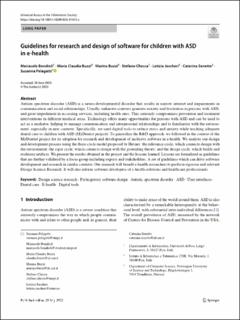| dc.contributor.author | Bondioli, Mariasole | |
| dc.contributor.author | Buzzi, Maria Claudia | |
| dc.contributor.author | Buzzi, Marina | |
| dc.contributor.author | Chessa, Stefano | |
| dc.contributor.author | Jaccheri, Maria Letizia | |
| dc.contributor.author | Senetti, Caterina | |
| dc.contributor.author | Pelagatti, Susanna | |
| dc.date.accessioned | 2023-08-29T08:42:11Z | |
| dc.date.available | 2023-08-29T08:42:11Z | |
| dc.date.created | 2023-08-01T08:47:10Z | |
| dc.date.issued | 2023 | |
| dc.identifier.issn | 1615-5289 | |
| dc.identifier.uri | https://hdl.handle.net/11250/3086131 | |
| dc.description.abstract | Autism spectrum disorder (ASD) is a neuro-developmental disorder that results in narrow interest and impairments in communication and social relationships. Usually, unknown contexts generate anxiety and frustration in persons with ASD, and great impediment in accessing services, including health ones. This seriously compromises prevention and treatment interventions in different medical areas. Technology offers many opportunities for persons with ASD and can be used to act as a mediator, helping to manage communication and interpersonal relationships and to familiarize with the environment, especially in new contexts. Specifically, we used digital tools to reduce stress and anxiety while teaching adequate dental care to children with ASD (MyDentist project). To generalize the R&D approach, we followed in the context of the MyDentist project for its adoption for research and development of inclusive software in e-health. We analyze our design and development process using the three-cycle model proposed by Hevner: the relevance cycle, which connects design with the environment; the rigor cycle, which connects design with the grounding theory; and the design cycle, which builds and evaluates artifacts. We present the results obtained in the project and the lessons learned. Lessons are formalized as guidelines that are further validated by a focus group including experts and stakeholders. A set of guidelines which can drive software development and research in similar contexts. Our research will benefit e-health researchers to perform rigorous and relevant Design Science Research. It will also inform software developers of e-health solutions and healthcare professionals. | en_US |
| dc.language.iso | eng | en_US |
| dc.publisher | Springer | en_US |
| dc.rights | Navngivelse 4.0 Internasjonal | * |
| dc.rights.uri | http://creativecommons.org/licenses/by/4.0/deed.no | * |
| dc.title | Guidelines for research and design of software for children with ASD in e-health | en_US |
| dc.title.alternative | Guidelines for research and design of software for children with ASD in e-health | en_US |
| dc.type | Peer reviewed | en_US |
| dc.type | Journal article | en_US |
| dc.description.version | publishedVersion | en_US |
| dc.source.journal | Universal Access in the Information Society | en_US |
| dc.identifier.doi | https://doi.org/10.1007/s10209-023-01013-x | |
| dc.identifier.cristin | 2164168 | |
| cristin.ispublished | true | |
| cristin.fulltext | preprint | |
| cristin.qualitycode | 1 | |

